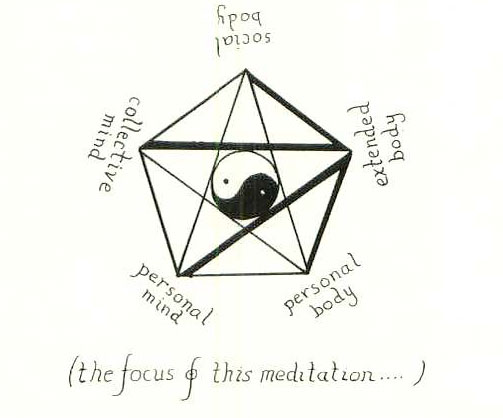VII. Technology and Social Reconstruction
The Scope of the Quest
1. In the Tao, order and disorder embrace and move through all. I see ecology, theology, and technology as more identical than distinct, and think our problems stem from our culture's Way of falsely dividing. In the roots of our language, nearest to that place before all divides, theo-logy is knowledge of God, i.e., of the action of order (and disorder) through the world. Eco-Iogy is knowledge of the House, in its order (and disorder), i.e., of the workings of whole systems. At this level, knowledge is still undifferentiated from practice; and so techno-logy, in its root meaning of "systematic knowledge," is scarcely distinct from the others, and thus might be used, as it was during the Industrial Revolution, to indicate the practical arts, collectively, and their science. All our subjects merge into one, which is nameless.
2. We are taught to see technology as a pathway of machines, leading up from stone axe through TV. But at its current summit, we recognize that a computer is just expensive junk hardware without its software component -- its programs, and behind them the systems by which people learn to generate them; and programs and systems of the spirit, parallel to those of the mind but mostly unnoticed. From this vantage, we understand that any technology exists largely in the mode of its use. In the hands of animals with a different genetic heritage of aggression, the stone axe would indicate a different technology. Thus tools draw our attention to the software that operates through them to organize energy. Going on, we see that methodical community organizing and psychotherapy are also technologies of energy-organizing -- broad ones, embracing many minor technologies, some employing physical tools. And we arrive back at technology in its root meaning of systematic knowledge in practice.
3. The full complexity of physical technology is as great as our own -- for machines are intimate extensions of the sensing/computing/effecting mechanisms of our life form, and the process of our cognition is compounded from experience through these.
Our son began to invent Geometry when he discovered his fist and tried to bring it to his mouth. For three days he hit himself in the eye with the fist it guided. Finally, he grasped that he was not an indivisible point but a complex of sensing parts in spatial relation, and solved the problem by turning his eyes off the fist and concentrating on touch to guide it home.
Months later, we got him a set of rings stacked on a pole and topped with a knob. He dumped them off, studied them, put one on his finger a few times to grasp the action, then put it on the pole; put others on, dumped them, put them on again, indifferent to size-order. Then he turned to the knob, which had only a one-sided hole, stuck it on his finger, then on the empty pole, but hadn't enough control to make it fit. Impasse, study. He picked up the pole, which was small enough to extend his hand easily, and reversed action by threading it through a large ring; crowed with delight. Then he practiced on a small one. Then he steadied the knob where it lay and managed for an instant to fit the pole in; failed; and wandered off in the daze of just-before-sleep. During these twenty minutes, we saw him learning through his body simultaneously a sense of extension and a sense of hypothesis based upon symmetry and example.
From such examples or yoga, we learn that the unit that "thinks" is not the naked brain but includes at least the body entire. (1) Extended as we are, by other flesh and matter, the physical mechanism that generates the patterns of our consciousness includes everyone's entrails and all our artifacts, bar none (and I think much more). Thus our machinery is integral to our every thought--even more deeply than McLuhan argues by citing how printing-press literacy has shaped our cognition. From our tools, astute aliens could deduce the politics of old age, the anthropology of love, and our image of Human, as these were actually practiced among us.
4. As we have a technology, industrial chemistry, to tailor molecules, so we have a meta-technology to manufacture our material technologies. These are not chaotic, some operating one way, some another: they form a systematic practice based on an ordered gestalt of principles. The technology of our technology is pernicious, witness the sky turning black; but it is first of all coherent. Its organization is everywhere dominated by the unbalanced Yang: Aggression/Centralization/Isolation/Grasping/Domination. Changing this clench is the substance of new politics, whose first directions are plain: moving toward balance in Receptivity/Decentralization/Collectivity/Release…
5. Each level of form's working is made manifest in every other as along the lines of this mandala, whose dark lines are the focus of this meditation:

Go to: Top | Next | OLSC Contents | Home